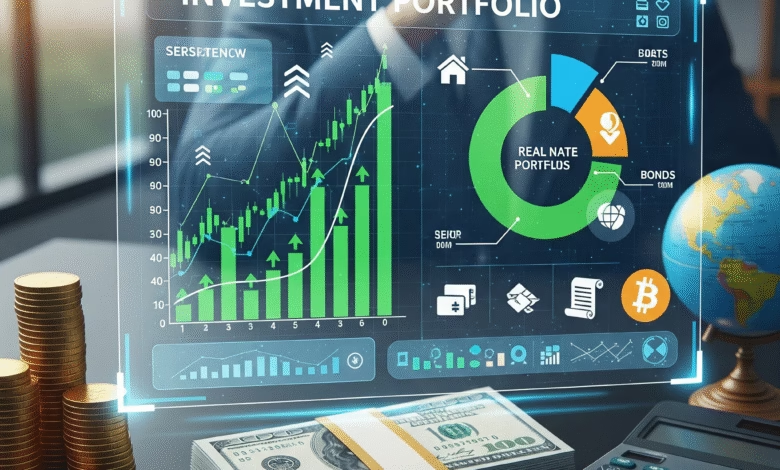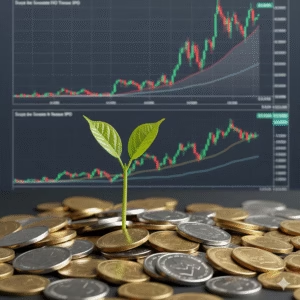
The stock market can seem like a chaotic and unpredictable place. One day, a company’s stock is soaring to new heights; the next, it might be tumbling down. For new investors, this constant fluctuation can be bewildering. What is the invisible force that dictates these prices? Why does a share of Apple cost what it does, and why did that price change since yesterday?
The truth is, stock prices aren’t set by a committee or determined by a complex formula in a secret room on Wall Street. The answer is both incredibly simple and infinitely complex.
At its core, a stock’s price is determined by one thing: the law of supply and demand.
That’s it. The price you see on your screen is simply the most recent price at which a buyer and a seller agreed to make a trade. But what influences millions of people to want to buy or sell a particular stock at any given moment? That’s where the complexity lies. This guide will break down the fundamental, economic, and psychological factors that work together to determine the price of every stock in the market.
The Core Engine: Supply and Demand in the Stock Market

Before we dive into the details, let’s solidify this core concept. Imagine a public auction for a rare, highly sought-after painting.
- If there are many enthusiastic bidders (high demand) but only one painting (limited supply), the bidders will try to outdo each other, pushing the price higher and higher.
- Now, imagine an auction for a common print with thousands of copies available (high supply) and only a few interested buyers (low demand). The sellers would have to lower their prices to attract a buyer.
The stock market works like a massive, continuous auction. The “supply” comes from the total number of shares available to be sold by current owners. The “demand” comes from all the investors who want to buy those shares.
- When demand is greater than supply (more buyers than sellers): The price goes up.
- When supply is greater than demand (more sellers than buyers): The price goes down.
The price of a stock is simply the equilibrium point where buyers are willing to pay what sellers are willing to accept. Our entire exploration from here on out is about understanding what causes shifts in that supply and demand.
Fundamental Factors: The Company’s Health and Performance
The most important long-term driver of demand for a stock is the performance and health of the underlying company. Think of this as the company’s report card. A business that is doing well will naturally attract more people who want to own a piece of it.
1. Earnings and Revenue
This is the most significant factor of all. A company’s ability to generate profit (earnings) from its sales (revenue) is the primary reason it exists.
- Strong, Growing Earnings: When a company consistently reports that it’s making more money than it did in the past, it signals a healthy, successful business. This increases investor confidence and drives up demand for the stock.
- Earnings Surprises: Wall Street analysts create earnings “estimates” each quarter. If a company reports earnings that are significantly higher than expected (a “positive surprise”), the stock price often jumps. If they miss those estimates, the stock usually falls, even if the company was still profitable.
2. Future Growth Prospects
Investors are always looking forward. A stock’s price isn’t just a reflection of its current performance, but also its potential for future growth. Factors that influence this include:
- Innovation and New Products: Is the company launching a groundbreaking product? (e.g., Apple’s next iPhone).
- Expansion into New Markets: Is the company growing its business in other countries or new demographic segments?
- A Strong Competitive Advantage: Does the company have a “moat”—like a powerful brand, proprietary technology, or economies of scale—that will allow it to continue growing and fending off competitors for years to come?
3. Financial Health (The Balance Sheet)
A company’s balance sheet provides a snapshot of its overall financial stability. Two key areas investors look at are:
- Assets and Liabilities: Does the company have more assets (things of value) than liabilities (debts)?
- Debt Levels: A company with a high amount of debt is seen as riskier. If an economic downturn occurs, that company might struggle to make its debt payments. A business with low debt and a lot of cash on hand is more stable and therefore more attractive to investors.
4. Dividends
When a profitable company shares a portion of its earnings with shareholders, it’s called a dividend. A consistent, and ideally growing, dividend can significantly increase demand for a stock, especially from investors seeking a steady income stream, like retirees. A dividend acts as a tangible reward for ownership and a signal of management’s confidence in the company’s financial stability.
External Forces: The Macro-Economic Environment

No company operates in a vacuum. Broader economic and global forces can have a massive impact on the supply and demand for all stocks, even for the healthiest companies.
1. Economic Indicators
The overall health of the economy plays a huge role in the stock market.
- Interest Rates: When the Federal Reserve raises interest rates, it becomes more expensive for companies to borrow money, which can slow their growth. Furthermore, higher rates make safer investments like bonds and savings accounts more attractive, potentially pulling money (demand) out of the stock market.
- Inflation: High inflation erodes the value of future profits and can lead to higher interest rates, both of which are generally negative for stock prices.
- GDP and Employment: Strong Gross Domestic Product (GDP) growth and low unemployment rates signal a healthy, growing economy, which is a positive backdrop for corporate profits and stock prices.
2. Industry Trends
Sometimes, the entire industry a company operates in is either booming or busting. A rising tide lifts all boats, and a falling tide can sink them. For example, a major technological shift toward artificial intelligence can boost demand for all companies in the AI space. Conversely, a shift away from fossil fuels could reduce the long-term demand for stocks of traditional oil companies.
3. Geopolitical Events and News
Global stability is good for business. Events like wars, trade disputes, terrorist attacks, and pandemics create uncertainty. Markets hate uncertainty. During times of global turmoil, investors often sell stocks (increasing supply) and move their money into safer assets like gold or government bonds, causing stock prices to fall.
The Human Element: Market Sentiment and Investor Psychology
If stock prices were only based on fundamentals and economic data, the market would be a much more predictable place. But it isn’t. That’s because every buy and sell decision is ultimately made by a human being (or an algorithm programmed by one), and humans are driven by emotion.
1. Fear and Greed
These are the two most powerful emotions that drive short-term market fluctuations.
- Greed and FOMO (Fear Of Missing Out): When a stock is rising rapidly, a frenzy can develop. Investors see others making money and jump in, not wanting to be left behind. This wave of demand, driven by greed, can push prices far above their logical value, creating a “bubble.”
- Fear and Panic Selling: When the market starts to fall, fear can take over. Investors who see the value of their portfolio dropping may sell in a panic to avoid further losses. This flood of supply can cause a market crash, pushing prices far below their fundamental value.
2. News, Hype, and Analyst Ratings
In the short term, perception can be more powerful than reality. A positive headline in a major news publication, a viral post on social media, or a prominent Wall Street analyst upgrading a stock from “Hold” to “Buy” can all create a sudden spike in demand. Conversely, a negative story or a downgrade can cause a rapid sell-off.
This is why a stock’s price can move dramatically even when nothing about the company’s actual business has changed. It’s the perception of the business that has shifted.
How Investors Try to Make Sense of It All: Valuation Methods

Given all these competing forces, how do serious investors decide what a stock should be worth? They generally use two main schools of thought to analyze stocks and predict where supply and demand might be heading next.
1. Fundamental Analysis
This is the practice of evaluating a company’s financial health, performance, and competitive position to determine its “intrinsic value.” A fundamental analyst pores over financial statements, earnings reports, and industry trends. They use metrics like the Price-to-Earnings (P/E) ratio to gauge if a stock is cheap or expensive relative to its profits. If their analysis shows a stock’s intrinsic value is higher than its current market price, they see it as a “buy.”
2. Technical Analysis
This approach ignores the company’s fundamentals and focuses entirely on stock chart patterns, trading volume, and price trends. Technical analysts believe that all the fundamental and psychological factors are already “baked into” a stock’s price and that historical price movements can be used to predict future movements. They use tools like moving averages and trend lines to identify buy and sell signals based on market sentiment.
A Complex Dance of Logic and Emotion

The price of a stock is the result of a constant, dynamic dance between millions of buyers and sellers around the world. It is a number that reflects the collective consensus of their hopes, fears, and analyses at any given second.
This price is influenced by three major forces:
- Company Fundamentals: The real-world performance and financial health of the business.
- Macro-Economic Conditions: The broader environment of interest rates, inflation, and global events.
- Market Sentiment: The ever-shifting psychological tide of human emotion, from unbridled optimism to paralyzing fear.
For the successful long-term investor, the key is to focus on the first factor—the fundamentals. While sentiment and economic news will cause prices to fluctuate wildly in the short term, it is the underlying quality and profitability of a business that will ultimately drive demand and create value over the long run.





